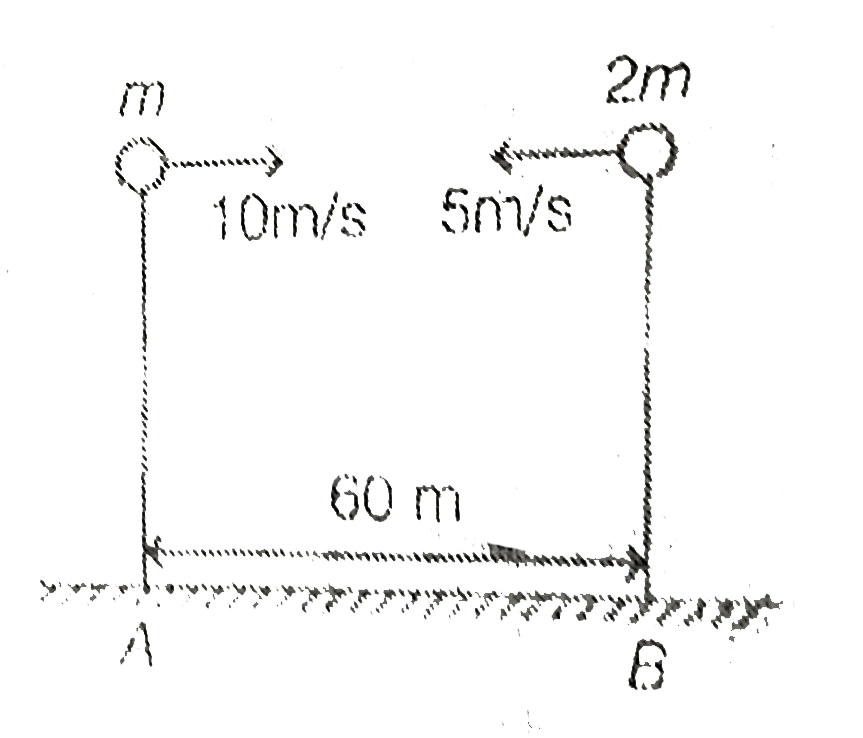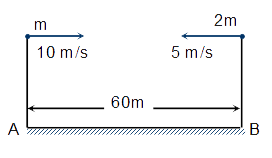Two spheres of same size, one of mass and another of mass , are dropped simultaneously from the top of Quata Minar . When they are above the ground, the two spheres have the same.
momentum
kinetic energy
potential energy
acceleratino
The correct Answer is:D
To solve the problem, we need to analyze the motion of the two spheres dropped from the height of 72 meters.
1. Understanding the Problem:
We have two spheres, one with a mass of 2 kg and the other with a mass of 4 kg, dropped from a height of 72 m. We need to determine what is the same for both spheres when they are 1 m above the ground.
2. Identify the Relevant Concepts:
- The two spheres are in free fall, meaning they are only influenced by gravity.
- The acceleration due to gravity (g) is approximately 9.81m/s2 and acts on both spheres equally, regardless of their mass.
3. Calculate the Height at Which They Are Analyzed:
- The height from which they are dropped is 72 m. When they are 1 m above the ground, they are at a height of 72−1=71m.
4. Determine the Motion Characteristics:
- Both spheres will have the same acceleration due to gravity, which is g. This is true for all objects in free fall, regardless of their mass.
5. Evaluate Other Quantities:
- Momentum: p=mv (depends on mass and velocity, different for both).
- Kinetic Energy: KE=12mv2 (depends on mass, different for both).
- Potential Energy: PE=mgh (depends on mass, different for both).
6. Conclusion:
The only quantity that remains the same for both spheres when they are 1 m above the ground is their acceleration. Therefore, the correct answer is that both spheres have the same acceleration.
Final Answer:
The two spheres have the same acceleration when they are 1 m above the ground.
---
We have two spheres, one with a mass of 2 kg and the other with a mass of 4 kg, dropped from a height of 72 m. We need to determine what is the same for both spheres when they are 1 m above the ground.
- The two spheres are in free fall, meaning they are only influenced by gravity.
- The acceleration due to gravity (g) is approximately 9.81m/s2 and acts on both spheres equally, regardless of their mass.
- The height from which they are dropped is 72 m. When they are 1 m above the ground, they are at a height of 72−1=71m.
- Both spheres will have the same acceleration due to gravity, which is g. This is true for all objects in free fall, regardless of their mass.
- Momentum: p=mv (depends on mass and velocity, different for both).
- Kinetic Energy: KE=12mv2 (depends on mass, different for both).
- Potential Energy: PE=mgh (depends on mass, different for both).
The only quantity that remains the same for both spheres when they are 1 m above the ground is their acceleration. Therefore, the correct answer is that both spheres have the same acceleration.
The two spheres have the same acceleration when they are 1 m above the ground.
Topper's Solved these Questions
- MOTION IN A STRAIGHT LINE & PLANE BOOK - VMC MODULES ENGLISHCHAPTER - MOTION IN A STRAIGHT LINE & PLANE EXERCISE - EFFICIENT
50 Videos
- MOCK TEST 9BOOK - VMC MODULES ENGLISHCHAPTER - MOCK TEST 9EXERCISE - PHYSICS (SECTION 2)
5 Videos
- Motion in Straight Line BOOK - VMC MODULES ENGLISHCHAPTER - Motion in Straight Line EXERCISE - IN-CHAPTER EXERCISE-J
10 Videos
Similar Questions
Two different masses are droped from same heights. When these just strike the ground, the following is same :
View SolutionTwo bodies of different masses are dropped simultaneously from same height. If air friction acting on them is directly proportional to the square of their mass, then,
View SolutionTwo spherical bobs, one metallic and other of glass, of the same size are allowed to fall freely from the same height above the ground. Which of the two would reach the ground earlier and why ?
View SolutionA body A of mass 4 kg is dropped from a height of 100 m. Another body B of mass 2 kg is dropped from a height of 50 m at the same time. Then :
View SolutionA body of mass 2 kg is dropped from rest from a height 20 m from the surface of Earth. The body hits the ground with velocity 10 m/s, then work done: (g=10m/s2)
View SolutionTwo particles one of mass m and the other of mass 2 m are projected horizontally towards each other from the same level above the ground with velocities 10 m/s and 5 m/s respectively . They collide in air and stick to each other . The distance from A , where the combined mass finally land is

View SolutionTwo particles, one of mass m and the other of mass 2m, are projected horizontally towards each other from the same level above the ground with velocities 10 m/s and 5 m/s, respectively. They collide in air and stick to each other. The distance of the combined mass from point A is

View SolutionTwo identiacal masses are as shown in figure. One is thrown upwards with velocity 20 m/s and another is just dropped simultaneously.
In the above problem, to what maximum height (from ground) with the combined mass rise ?
View SolutionTwo small balls of the same size and of mass m1 and m2(m1>m2) are tied by a thin light thread and dropped from a large height. Determine the tension T of the thread during the flight after the motion of the balls has become steady. (Air resistance force is same on two balls)
[Take m1=2kg, m2=1kg, g=10m/s2]
View SolutionTwo bodies of masses M and m are allowed to fall from the same height. It the resistance for each be the same, then, will both the bodies reach the earth simultaneously ?
View Solution
